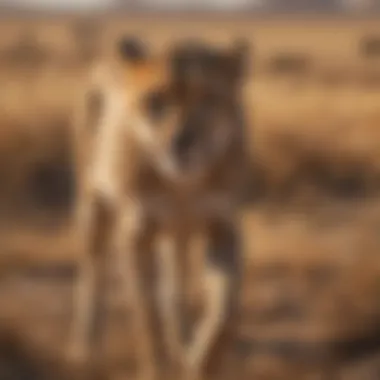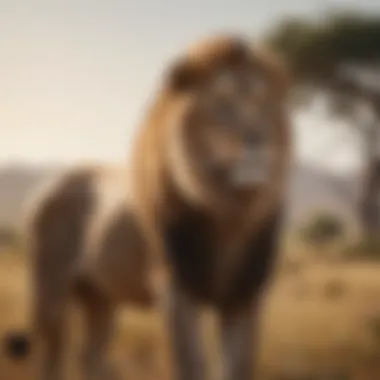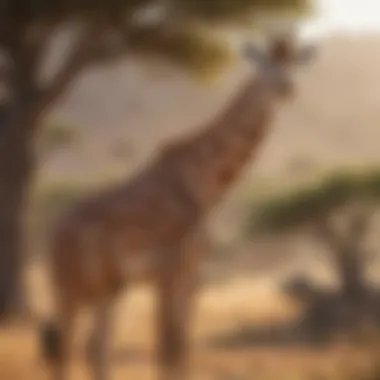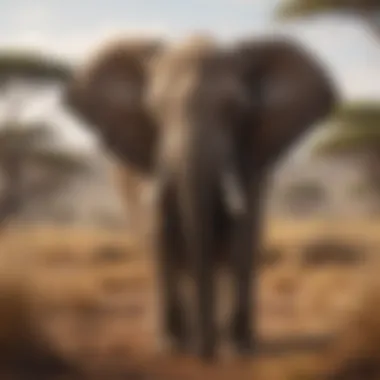Unlocking the Enigmatic World of Endangered Savanna Animals


Animal Species Profile
Meet the diverse array of wildlife that call the savanna home. From the formidable lions to the elegant giraffes, each species plays a crucial role in maintaining the balance of this vibrant ecosystem.
Lion
-### Physical characteristics and appearance The majestic lion, with its golden mane and powerful build, stands as a symbol of strength and grace. Their sharp claws and teeth make them formidable predators, perfectly adapted to thrive in the savanna landscape. -### Natural habitat and distribution Lions are predominantly found in the grasslands and open plains of the savanna, where they form social groups known as prides. These prides establish territories to hunt for food and raise their young. -### Behavior and social interactions Within a pride, lions exhibit complex social hierarchies and communal care for their cubs. Their communication involves vocalizations, body language, and scent marking, all essential for coordination in hunting and defense.
Giraffe
-### Physical characteristics and appearance With their long necks and legs, giraffes are the tallest land animals, towering over the savanna landscape. Their distinctive coat pattern provides camouflage from predators, while their tongue helps them reach high branches for food. -### Natural habitat and distribution Giraffes can be found in savannas across Africa, where they feed on leaves from acacia trees. Their ability to spot danger from afar and run at high speeds make them well-adapted to evade threats in the wild. -### Behavior and social interactions These gentle giants form loose social groups, with females and calves often congregating together. Female giraffes display a unique social structure where they establish bonds and help each other during birthing and calf rearing.
Conservation & Wildlife Efforts
The conservation status of these iconic savanna animals is a major concern due to habitat loss, poaching, and human-wildlife conflict. Conservation initiatives led by organizations such as the African Wildlife Foundation and Wildlife Conservation Society aim to protect these species through habitat restoration, anti-poaching efforts, and community engagement. Recent success stories include the recovery of certain lion populations in protected areas, highlighting the positive impact of conservation work.
Animal Behavior & Psychology
Understanding the intricate behaviors and psychology of savanna animals sheds light on their adaptability and intelligence. From the complex communication of elephants to the problem-solving skills of hyenas, each species demonstrates unique cognitive abilities and social dynamics essential for their survival in the wild.
Unique Facts & Trivia
Uncover the fascinating world of savanna animals with these little-known facts and surprising behaviors:
- Lions are the only truly social big cats, forming prides that cooperate in hunting and raising young.
- Giraffes have a unique way of drinking water, using their long tongues and powerful suction to avoid bending down too far.
- Elephants are known for their exceptional memory and emotional intelligence, forming lasting bonds with family members and exhibiting compassion towards one another.
- Hyenas have intricate social structures within their clans, with females dominating males and exhibiting strategic hunting tactics.
Pet Care & Tips
While these savanna animals are best left in the wild, pet owners can learn valuable lessons in care and commitment from studying their behavior:
- Mimicking natural habitats through enrichment activities can benefit pets' physical and mental well-being.
- Providing a balanced diet and regular exercise ensures the longevity and vitality of companion animals.
- Positive reinforcement techniques and socialization play a key role in shaping pets' behavior and enhancing their overall welfare.
Introduction to the Savanna: Unfolding the Ecosystem
In this fascinating section of the article, we embark on a journey into the heart of the savanna ecosystem. The savanna, with its vast grasslands and scattered trees, represents a critical habitat for a myriad of species, both iconic and endangered. Understanding the nuances of this ecosystem is crucial as it forms the backdrop for the survival of many animals facing threats today. By delving into the intricate web of relationships and dependencies within the savanna, we gain insights into why this unique landscape demands our attention for conservation efforts.
Defining the Savanna Ecosystem: Understanding Its Essence
Characteristics of the Savanna: A Closer Look


The savanna is characterized by its expansive grasslands punctuated by isolated trees, creating a picturesque mosaic that supports a diverse range of wildlife. The blend of grasses and trees not only provides food and shelter for various species but also plays a vital role in regulating the ecosystem's dynamics. The savanna's distinctive fire-adapted vegetation and variable rainfall patterns contribute to its resilience in the face of environmental challenges, making it a focal point for conservation efforts.
Importance of the Savanna Ecosystem: Nurturing Life Amidst Challenges
The importance of the savanna ecosystem cannot be overstated. It serves as a crucial habitat for numerous endangered species, offering a lifeline in a world rife with threats. From providing grazing grounds for large mammals to offering nesting sites for birds, the savanna's significance reverberates throughout the animal kingdom. Its role in fostering biodiversity and maintaining ecosystem balance highlights why safeguarding this habitat is paramount in the ongoing battle against extinction.
Biodiversity in the Savanna: A Kaleidoscope of Life
Species Variety: Diving into Diversity
The savanna boasts a staggering array of species, from towering giraffes to elusive leopard populations. Each animal plays a unique role in the intricate web of life that thrives in this dynamic ecosystem. The diverse mix of herbivores, carnivores, and omnivores paints a vivid picture of nature's complexity, emphasizing the richness that defines the savanna's biodiversity. Exploring the myriad adaptations and behaviors of these creatures unveils a world teeming with marvels waiting to be discovered.
Role of Endangered Animals: The Fragile Balance
Endangered animals in the savanna face unprecedented challenges that threaten their very existence. Factors such as habitat loss, poaching, and human-wildlife conflict loom large, pushing these species to the brink. However, their presence is crucial for maintaining the ecological equilibrium of the savanna, underscoring the urgent need for conservation actions to secure their future. By unraveling the pivotal roles these endangered animals play in the ecosystem, we gain a profound appreciation for their irreplaceable contributions to the savanna's tapestry of life.
Challenges Faced by Savanna Wildlife
The challenges encountered by wildlife in the savanna play a pivotal role in shaping the ecosystem's dynamics and the future of its inhabitants. From human-wildlife conflicts to habitat loss and fragmentation, the obstacles faced are multifaceted and require comprehensive solutions. These challenges not only impact the endangered species residing in the savanna but also have broader implications for the ecological balance of the region. Understanding and addressing these challenges are crucial for ensuring the long-term survival of the diverse wildlife population.
Human-Wildlife Conflict
Impact on Endangered Species
The impact of human-wildlife conflict on endangered species within the savanna is profound. As human populations expand and encroach upon natural habitats, conflicts between humans and wildlife escalate, leading to detrimental consequences for endangered species. The resulting competition for resources, territory encroachment, and direct threats pose significant risks to the survival of vulnerable animal populations. Mitigating these conflicts is imperative to safeguarding the endangered species and fostering coexistence between wildlife and communities.
Mitigation Strategies
Mitigation strategies are essential to reducing the negative effects of human-wildlife conflict on endangered species. Implementing measures such as designated wildlife corridors, community-based conservation programs, and innovative deterrent techniques can help minimize conflicts and promote harmonious cohabitation. By fostering dialogue between stakeholders, raising awareness on conservation issues, and empowering local communities, effective mitigation strategies can address the root causes of conflict and enhance the protection of endangered species in the savanna.
Habitat Loss and Fragmentation
Effects on Wildlife Population
The effects of habitat loss and fragmentation on the savanna's wildlife population are alarming. As human activities such as agriculture, urbanization, and infrastructure development encroach upon natural habitats, the expansive savanna landscapes are increasingly fragmented, leading to isolation of wildlife populations. This fragmentation hinders ecological processes, disrupts migration patterns, and diminishes genetic diversity among species, ultimately jeopardizing the long-term viability of wildlife populations.
Conservation Challenges
Conservation challenges stemming from habitat loss and fragmentation present formidable obstacles to wildlife preservation efforts in the savanna. Balancing developmental needs with conservation priorities, securing protected areas, and implementing sustainable land-use practices are critical challenges faced by conservationists. Addressing these challenges requires interdisciplinary approaches, community engagement, and policy interventions to mitigate the adverse impacts of habitat loss and fragmentation on savanna wildlife.


Poaching and Illegal Wildlife Trade
Threat to Endangered Species
The threat posed by poaching and illegal wildlife trade to endangered species in the savanna is a grave concern. Despite global conservation efforts, wildlife crime remains a significant threat to the survival of iconic species such as rhinos, elephants, and lions. The illegal trade in wildlife products, driven by demand for exotic pets, trophies, and traditional medicine, results in the depletion of endangered species populations and disrupts delicate ecosystems. Combating poaching and illegal wildlife trade is essential for protecting the biodiversity and ecological integrity of the savanna.
International Efforts
International efforts play a crucial role in combating poaching and illegal wildlife trade in the savanna. Collaborative initiatives between countries, enforcement of international wildlife trafficking regulations, and support for local law enforcement agencies are essential components of global anti-poaching efforts. By fostering cooperation, sharing intelligence, and implementing stringent measures, international efforts strive to dismantle wildlife trafficking networks, disrupt illicit markets, and enhance protection for endangered species in the savanna.
Iconic Endangered Animals of the Savanna
In this section, we delve into the significance of the Iconic Endangered Animals of the Savanna within the broader narrative of this article. The inclusion of these iconic species highlights not only their individual importance but also serves as a lens through which to understand the broader challenges faced by savanna wildlife. By focusing on lions, elephants, rhinos, and cheetahs, we shed light on the diverse range of species grappling with survival in the changing savanna ecosystem. Exploring these emblematic animals not only allows us to appreciate their cultural significance but also underscores the urgent need for conservation efforts to protect their existence.
Lions
Population Decline
Discussing the issue of Population Decline among lions is pivotal in understanding the precarious state of these majestic creatures. The gradual reduction in lion numbers not only impacts the species itself but also has cascading effects on the savanna ecosystem as a whole. By highlighting aspects such as habitat loss, human-wildlife conflict, and poaching, we can grasp the complexities driving this decline. The dwindling lion population underscores the pressing need for focused conservation strategies and collaborative efforts to ensure their continued presence in the savanna landscape.
Conservation Initiatives
Examining the realm of Conservation Initiatives aimed at lions reveals a tapestry of efforts woven to safeguard these apex predators. From community-based projects to international conservation programs, various initiatives are working towards mitigating the threats faced by lions. By analyzing the effectiveness of strategies like habitat protection, anti-poaching measures, and community engagement, we gain insight into the multidimensional approach required to conserve lion populations. These initiatives not only aim to secure a future for lions in the savanna but also underscore the interlinkage between species survival and ecosystem health.
Elephants
Ivory Trade Impact
Exploring the impact of the Ivory Trade on elephants illuminates the dire consequences of poaching for tusks. The illicit trade in ivory represents a severe threat to elephant populations, driving them towards the brink of extinction. Understanding how the demand for ivory shapes poaching activities heightens awareness about the urgent need for stringent laws and international cooperation to combat this illicit trade. Addressing the ivory trade's impact goes beyond elephant conservation; it symbolizes a stand against illegal wildlife exploitation and the need for ethical consumer choices.
Protection Measures
Delving into the world of Protection Measures for elephants underscores the diverse strategies employed to safeguard these gentle giants. From anti-poaching patrols to habitat conservation, these measures play a vital role in ensuring the safety and well-being of elephants in their natural habitat. By examining the effectiveness of techniques such as GPS tracking, community surveillance, and conservation agreements, we gain a holistic view of the proactive steps taken to protect elephants. Implementing robust protection measures not only secures the future of elephants but also contributes to the wider goal of preserving biodiversity in the savanna ecosystem.
Rhinos
Poaching Crisis
The Poaching Crisis facing rhinos paints a grim picture of relentless illegal wildlife activities driven by the demand for rhino horns. The brutal poaching of rhinos not only decimates populations but also disrupts the intricate balance of the savanna ecosystem. By shedding light on the brutality of poaching, we emphasize the urgent need for stricter laws, intensified enforcement, and community involvement to combat this crisis. Addressing the poaching crisis necessitates a comprehensive approach that combines anti-poaching efforts with demand reduction campaigns to protect rhinos from imminent extinction.


Anti-Poaching Efforts
Exploring the landscape of Anti-Poaching Efforts reveals a battlefield where dedicated individuals and organizations stand between rhinos and poachers. Through initiatives such as aerial surveillance, horn devaluation, and intelligence-led operations, anti-poaching teams strive to safeguard rhinos from the illegal wildlife trade. Assessing the efficacy of these efforts highlights the pivotal role played by anti-poaching units in disrupting poaching networks and protecting rhino populations. Supporting anti-poaching endeavors is not just about saving a species but upholding values of conservation, justice, and ethical responsibility in safeguarding the natural heritage of the savanna.
Cheetahs
Threats to Survival
Unpacking the diverse threats faced by cheetahs offers a glimpse into the challenges haunting the world's fastest land mammal. From habitat loss to human-wildlife conflict, cheetah populations grapple with numerous obstacles that jeopardize their survival. Examining the complex web of threats sheds light on the urgent action required to ensure the continuity of cheetah populations in the savanna. By understanding the dynamics of these threats, we pave the way for informed conservation strategies that address the root causes endangering cheetahs in their natural habitat.
Conservation Strategies
Surveying the realm of Conservation Strategies tailored for cheetahs unveils a spectrum of approaches aimed at mitigating the perils facing this vulnerable species. Incorporating initiatives such as habitat restoration, genetic diversity conservation, and community education, these strategies aim to secure a sustainable future for cheetahs. Analyzing the impact of conservation efforts on cheetah populations showcases the importance of adaptive management and collaboration among stakeholders. Implementing robust conservation strategies not only safeguards cheetahs but also underscores the interconnectedness of species preservation with the well-being of the entire savanna ecosystem.
Conservation Measures and Future Outlook
In the exploration of the endangered animals of the Savanna, the section on Conservation Measures and Future Outlook holds significant importance. This segment delves into the critical strategies and considerations essential for safeguarding the biodiversity of this iconic landscape. Addressing the looming threats faced by the wildlife and outlining sustainable solutions encapsulates the essence of this topic. By shedding light on the pressing issues and potential pathways for conservation, this section lays the foundation for a comprehensive understanding of the challenges and opportunities within the Savanna ecosystem.
Global Conservation Efforts
International Organizations
International Organizations play a pivotal role in shaping the global conservation landscape. In the context of protecting the endangered animals of the Savanna, these entities bring together expertise, resources, and concerted efforts on an international scale. Their reach spans across borders, addressing conservation challenges with a unified approach. The unique feature of International Organizations lies in their ability to drive collaborative initiatives that transcend geographical boundaries, amplifying the impact of conservation endeavors. While their influence is vast, careful consideration must be given to ensure that their interventions align with local needs and environmental contexts.
Innovative Conservation Projects
Innovative Conservation Projects introduce cutting-edge methodologies and technologies to the realm of wildlife preservation. These initiatives incorporate novel techniques that optimize conservation outcomes and sustainability. By harnessing innovation, such projects open new avenues for addressing complex conservation issues in the Savanna. Their emphasis on experimentation and adaptive practices makes them a valuable addition to the conservation toolkit. However, it is imperative to balance innovation with proven traditional approaches to ensure the efficacy and long-term viability of conservation efforts.
Community Involvement
Local Initiatives
Local Initiatives emerge as grassroots movements that empower communities to actively participate in conservation initiatives. These efforts tap into local knowledge and traditions, fostering a sense of ownership and stewardship among residents living in and around the Savanna. The key characteristic of Local Initiatives is their ability to integrate traditional practices with modern conservation principles, creating a holistic approach to wildlife protection. While these initiatives hold promise, challenges such as resource constraints and awareness gaps need to be addressed to maximize their impact on endangered species.
Sustainable Practices
Sustainable Practices encompass a range of environmentally conscious actions aimed at reducing human impact on the Savanna ecosystem. These practices promote the use of renewable resources, minimal waste generation, and responsible land management. The key characteristic of Sustainable Practices lies in their focus on long-term ecological balance and the well-being of wildlife populations. While advocating for sustainability is crucial, implementing these practices may pose challenges in the face of economic pressures and competing interests. Balancing conservation goals with socio-economic needs is essential for the successful integration of sustainable practices in the Savanna.
Hope for Endangered Species
Recovery Prospects
Recovery Prospects offer a glimmer of hope for the survival and resurgence of endangered species in the Savanna. These prospects outline concrete strategies and action plans aimed at rebuilding dwindling populations and restoring habitats. The key characteristic of Recovery Prospects is their emphasis on targeted interventions tailored to the specific needs of each species under threat. While the potential for species recovery is promising, external factors such as climate change and human encroachment present ongoing challenges that must be navigated effectively.
Continued Conservation Efforts
Continued Conservation Efforts underscore the persistent commitment required to safeguard the future of endangered animals in the Savanna. These efforts encompass a range of activities, from anti-poaching measures to habitat restoration projects, aimed at mitigating threats and promoting coexistence between wildlife and human communities. The key characteristic of Continued Conservation Efforts is their unwavering dedication to sustaining conservation momentum over the long term. While progress has been made, the journey towards comprehensive protection of the Savanna's wildlife calls for continued vigilance, innovation, and collaboration.







